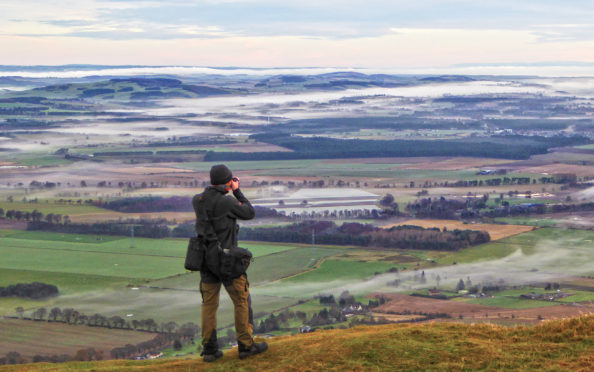At 7am the fog was rolling in over the farms, so I rushed up my local hill to watch the sunrise. I spent a sublime two hours up above the fog watching the beautiful lightshow unfold.
But when I got home and downloaded my camera I found there were 190 photos. As an enthusiastic amateur I do snap loads of piccies but even I was taken aback, because I had no recollection of having taken so many.
That’s one photo every 37 seconds! Had I actually SEEN what was around me with my own eyes, or had I viewed it only through a lens?
Clearly, digital technology is marvellous but I do wonder how it has affected my experience of the great outdoors. I’m old enough to remember, with both nostalgia and disbelief, being limited to 36 photographs on a walk.
Not that snapping 36 photos meant you actually got 36 back, of course. How many of us excitedly rushed to Boots on our lunch hour only to find the warning sticker of doom on the envelope and 36 photos of a nuclear explosion?
I quite miss those days because the financial and technological limitations meant my photographic eye was, through necessity, sparing. One film would last me several hillwalks. That’s why I only have about 500 hillwalking photos from between 2003 and 2008 (when I got my first digital camera). These days I’ll take that many in just one week.
But here’s the thing. Before digital I don’t remember wishing I could have taken more photos, and only rarely did I feel I’d been denied a photo for reasons of thrift. I was just better at being discerning. But what happens to a discerning eye when you can take 10,000 photos rather than 36?
I suppose the question, both then and now is….“why take photos?” The cynical narcissist in me says it’s because it feels good when they’re well received on social media. Positive social media interactions release dopamine into the brain and I’m as addicted to that as the next 40-something. But that can’t be the whole story because I was photography-mad long before social media arrived.
I got my first camera (one of those oblong manual wind-on things) when I was nine, and my first SLR when I was 15. I have always taken photos, snapping sunsets as enthusiastically in 1986 as I did in 2016. However, in 1986 I took just one photo rather then 50, and there was nowhere to ‘share’ them afterwards. Well, other than on the kitchen table with my mum. And yet I’ve still got boxes and boxes of those 6×4 flippy photo albums. Why? I never look at them. What’s the point?
I don’t have an easy answer, other than photography gives me pleasure. Curiously though, even in pre-digital times I worried about the effect photography was having on me. When I lost two spent (but unprocessed) rolls of film whilst exploring New Zealand in 2001, I subsequently plunged into what I can only describe as mourning. My embarrassingly melodramatic diary from that day says:
I don’t feel like writing. I feel I’ve been robbed, like being the victim of an injustice. I don’t know what’s more disturbing, the fact I’ve lost some photos or the fact I’m so upset.
I realised, for the first time, that the lens somehow changed the way I experienced things and I therefore questioned why I was even travelling. Was it to SEE New Zealand or to take photos of it?
But if I was concerned that taking 36 photos in two weeks changes the way you experience things, what on earth happens when it’s one every 37 seconds!? Intriguing studies abound of how taking photographs can affect our brain’s ability to ‘encode’ an experience into memory, with some results showing that even if you sit and stare at something after you’ve taken just one photo of it, your ability to recall details afterwards is adversely affected by having taken that photo.
I’ve tried leaving my camera at home sometimes. It’s oddly liberating but I’m always nervous in case a golden eagle appears, or I happen upon a beautiful frosty scene, or 100 other possible things happen that I can’t take a photo of. I still create memories of course, so what does it matter if I don’t get a photo? Ugh, I don’t know, but for some reason it does, so I won’t be giving my camera up any time soon. Besides, photos have created so many opportunities for me in recent years, and taking them does give me (and others) pleasure.
Photography and social media aren’t bad things in themselves, of course, but it’s good to at least be aware of your motivations and the impact that technology has on you. That way you can hopefully recognise if and when something has gone too far. It’s funny really. So much of what I do is about encouraging people to get outdoors, to see and experience things with their own eyes, but arguably I could do with following my own advice and doing just that.
Ben Dolphin is an outdoors enthusiast and president of Ramblers Scotland











